21 Material Culture
Tori M Saneda
Earliest Material Culture
Stone Tools
The earliest evidence of material culture is in the form of stone tools. This does not mean that tools weren’t used earlier. It’s possible that proto- and early-hominins were using tools that were made of organic materials that did not preserve, e.g., sticks used to fish for termites. Recent finds from Dikika, Ethiopia in the Afar region, indicate that Au. afarensis used stone tools to extract marrow from bones 3.4 million years ago. What this study does not show is whether Au. afarensis was making tools or using found rocks. You can read more about this recent find and the Dikika Research project (optional). However, an announcement in May 2015 is rewriting what we know about stone tools.
Harmand et al. (2015) published that they had found 3.3 million-year-old (myo) stone tools at Lomekwi 3, West Turkana, Kenya, which they propose calling Lomekwian as the tools predate Oldowan tools (see below) by 700,000 years. What is particularly interesting is that the oldest Homo fossils found in West Turkana are 2.34 mya. Kenyanthropus platyops (not covered in the overview of early hominins, but you can learn about it at Becoming Human) is the only hominin known from the area at that time, although Au. afarensis is known from 3.39 mya. Questions remain as to which hominin left behind the assemblage of 149 artifacts (an assemblage is a group of artifacts found together at a specific site), including flake fragments, worked cobbles, and cores, and how it compares with Oldowan tools. As this is such a recent discovery, it is not covered in any more detail on this page.
Osteodontokeratic Culture
Paleoanthropologists have long been interested in the cultural aspects of hominins. Not all of the tool industries identified in the past stood the test of time. The osteodontokeratic tool culture was the earliest tool industry to be described, but was later discredited. In 1949, Raymond Dart, who discovered Audstralopithecus africanus, recorded numerous broken animal and hominin bones, and horns and teeth at Makapansgat Cave, South Africa. The bones were broken and gnawed and many showed puncture marks. Dart interpreted this find as evidence that hominins used bone, teeth, and horn (osteo-donto-keratic) as weapons, not only for hunting but against one another. From this interpretation sprang the idea that early hominins were violent killer-apes, an idea that has remained in the popular zeitgeist to this day.
Years later, C.K. Brain, working at Swartskrans, South Africa, found a similar artifact assemblage. Brain found that about 40% of the hominin fossil assemblage was comprised of young robust australopiths, many of which looked similar to the bones fossils that Dart had found at Makapansgat–they were broken, gnawed, and had puncture marks. After a careful taphonomic study, Brain developed the Leopard Hypothesis. He found that the puncture marks were consistent with the width of leopard canines. He concluded that the robust australopiths were hunted. The reason that there were so many young australopiths in the assemblage is that they were more vulnerable, not having the same predator avoidance skills as adult australopiths. He also noted that many of the bones had cut marks over tooth marks, indicating that an animal had gnawed the bones and then a hominin, probably Homo hablis, which was also found at the site, scavenged the australopith bones. Brain’s work effectively debunked Dart’s osteodontokeratic proposal.
Oldowan Tool Industry

The oldest stone tool assemblage is the Oldowan tool industry (at least it is the oldest until the field comes to a consensus about Lomekwian tools). First identified at Olduvai Gorge, Tanzania by Louis and Mary Leakey, Oldowan tools are stone pebble tools manufactured using a hard percussion technique. This technique involves striking two stones together to knock off a flake or create an edge on a piece of stone. While this seems like a simple technique, to make one of these tools, the individual needs to be able to understand how the stone will break when struck. The presence of Oldowan tools is an indication of changing cognitive abilities.
Originally, paleoanthropologists thought that the hammerstone was the primary tool used, but microwear analysis, a methodology whereby stone tools are examined under a microscope and the use wear patterns compared to use wear patterns established through experimental archaeology, indicates that flake tools were the primary tool. Oldowan tools were used for cutting, chopping and scraping.
Louis Leakey believed that Oldowan tools were evidence that Homo hablis, the fossil hominin found associated with the tools at Olduvai Gorge, hunted, especially since numerous animal fossils were found at the site. However, the mere presence of stone tools and animal fossils does not confirm hunting behavior. In the early 1980s, Rob Blumenschine conducted a year-long study on the Serengeti and in riparian (river) habitats. Blumenschine observed around 250 feedings by both predatory and scavenger carnivores such as lions, cheetahs, hyenas, and vultures. What he noticed was that when a predator ate, they would eat the meatiest parts of the body, leaving behind primarily limb bones. He suggested that if hominins were hunting that the artifact assemblage should contain those animal bones with the most meat. If hominins were scavenging then limb bones would dominate the fossil animal bone assemblage. Additionally, he noted that if hominins hunted then cut marks from tools would underlie animal tooth marks and vice versus if they were scavenging.

Armed with this information, the Olduvai Gorge material was reexamined. Several new points came to light: 1) the damage on the bones was most similar to that left by carnivore activity, 2) the percentage of limb bones in the artifact assemblage met the expectations of scavenging behavior, and 3) the cut marks overlay teeth marks. It was clear at this point that Homo hablis was not hunting but scavenging. While conducting his research, Blumenschine used Oldowan tools to scavenge a carcass. He found that in about 10 minutes, it was possible to extract enough meat and marrow to meet about 60% of the estimated daily caloric intake (approximately 1500 calories). Blumenschine demonstrated that it was an easy feat to scare off other scavengers and even some predators in order to gain access to the carcass. As a subsistence strategy, scavenging does have some advantages:
- it is less dangerous as the scavenger does not have to risk themselves for the kill
- it is quicker as the scavenger can simply follow the roar of the lion or look for vultures circling overhead
- there is less energy expenditure for the reasons listed above and the short amount of time it would take to butcher the remaining carcass using stone tools
The first definitive evidence of hunting is from Schöningen, Germany, in the form of wooden spears dated to 400,000 years. The artifacts were identified as spears because they have similar morphology to modern javelins, e.g., the balance point is 1/3 the way from the spear point. The spears are about 7 feet long with sharpened points and were found with the remains of butchered horses.
Until recently, one of the long running debates has centered on who was the first tool user. With the recent announcement by the Dikika Research Project, the nature of that debate may change from who was the first user to who was the first maker. The previously oldest tools came from Gona, Ethiopia dated to 2.4 million years ago. As these tools were not found associated with any hominin fossils, paleoanthropologists debated who made the tools. The time frame puts several hominins in play: Au. garhi, Paranthropus robustus, H. rudolfensis, and H. habilis. Studies show that P. robustus had the hand morphology for making tools, but many do not think that the species had the cognitive abilities. Plus, no P. robustus fossils have been found with stone tools. The same goes for Au. garhi. All researchers agree that Homo was making and using tools. Again, the recently reported finds from Lomekwi 3 may end up demonstrating that an early australopith was the first tool maker.
Acheulean Tool Industry

One thing we see with tool technologies is that as time passes the tools become more and more sophisticated. About 1.9 million years ago, Homo erectus invented a new sophisticated technology for making stone tools, which started with the hard percussion technique, but then employed a soft hammer technique to get more refined and sharper edges. This new tool industry is called the Acheulean.
The Acheulean tool industry, first found at St. Acheul, France, is characterized by bifacial tools. This means that the stone is worked on both sides. This tool industry is a marked step in the cognitive abilities of hominins because the tool has to be conceptualized prior to manufacturing. Dozens of flakes have to be removed precisely in order to maintain the symmetry of the tool and keep the edges straight. The signature tool of the Acheulean tool industry is the tear-drop shaped handaxe. Often referred to as the Swiss Army knife of the Pleistocene, the handaxe was an all-purpose tool used for a multitude of activities including digging, sawing, and cutting.
Mousterian Tool Industry
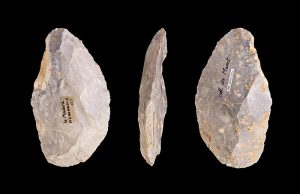
Neanderthals took the next step in the evolution of stone tools by making tools for specialized tasks. Named after a cave site in Le Moustier, France, these flake tools developed out of a manufacturing technique called the Levallois. This technique first arose with the Acheulean and is characterized by preparing the core of raw material from which flakes can be struck and then worked. Sharper tools with a finer edge are produced using this technique. Neanderthals shaped these flakes into tools like scrapers, blades, and projectile points, specifically spear points. In fact, at Neanderthal caves sites in the Middle East, there are a higher percentage of spear points found than at neighboring Homo sapiens sites. Mousterian tools are a technological advance, taking a high degree of conceptualization and knowledge of the properties of the stone. On average, it takes about 200 blows to make one flake tool.
Upper Paleolithic Tool Industries
The Upper Paleolithic of Europe begins 45,000 years ago and ushers in further advances in tool technology. Not only are there a wider variety of tools made, but new materials are used, including bone and antler. Several regional types of tool industries emerge in the Upper Paleolithic. The first is the Aurignacian, which is characterized by blade tools. A blade tool is a tool that is at least twice as long as it is wide. The benefit of blade tool technology is that blades can be easily knocked off a prepared core and then made into a wide range of tools, e.g., projectile points, drills, needles, scrapers, burins. By 31,000 years ago, the Aurignacian is widespread throughout Europe, allowing archaeologists to trace the movement of modern Homo sapiens.

The Aurignacian tool industry disappears from the archaeological by 29,000 years ago. It is replaced by the Gravettian tool industry, which is found at European sites until around 21,000 years ago. This tool industry is characterized by small blades and denticulate (serrated) knives. The Gravettian also has projectile points with blunting (steep backing) that can be hafted onto a shaft. The small size of some of the projectile points leads some archaeologists to surmise that the bow and arrow was invented during the Gravettian, although the first definitive evidence of arrows comes from Stellmoor, Germany (10,500 years ago). It does appear that the atlatl, or spearthrower, was invented during this time frame. This is an important advance as it allowed a hunter to throw farther and with more force, making hunting the megafauna of the period a little safer.
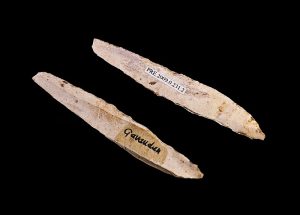
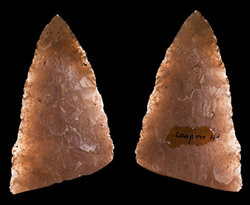
The Gravettian is followed by the Solutrean and the Magdelenian tool industries. the Solutrean tool industry is characterized by bifacial, leaf-shaped projectile points. As far as stone tools go, the Solutrean points are some of the best made points of the Upper Paleolithic. The technology flourished from around 21,000 to 16,000 years ago, but then disappears for thousands of years until a similar manufacturing process appears in North America during the Clovis period. to explain this, some archaeologists propose that there was a migration of peoples from the Iberian Peninsula to North America in the late Pleistocene who carried the technology with them; however, other there is little other evidence to support this contention. It is probable that the manufacturing techniques was rediscovered by North America’s early inhabitants.
One of the reasons that Solutrean points were finely made was because the stone was heat treated before it was worked. Heat treatment means that the stone was placed in a fire for a period of time, making it possible to make pressure flaking more precise. Heat treating was also a hallmark of the Magdelenian tool industry, 16,000-11,000 years ago. Bone and antler tools flourish during the Magdelenian. Harpoons appear in the archaeological record, with true barbed harpoons showing up around 13,000 years ago.

Homo erectus Culture

Homo erectus’ diet was probably similar to its ancestors. This hominin probably scavenged for meat and foraged for plants, especially tubers. The evidence for hunting is complicated by the fact that most of the sites where there is a multitude of animal bone could be explained by the fact that animals and hominins were likely drawn to the same water sources, which could account for their presence. Cave sites like Zhoukoudian where the presence of animal bones such as elephants might be explained by human activity are marred by the presence of hyena bones. It is possible that the scavenging hyenas dragged the bones in to the cave.
The controlled use of fire is one of the cultural adaptations that changed human history. Fire allowed our early ancestors to inhabit glacial environments, extend working and socialization hours, assist with hunting, offer a measure of protection from wild animals and of course cook their food thereby killing parasites and bacteria and making food more digestible by removing toxins. Just when our ancestors began to use fire is hotly debated in paleoanthropology and archaeology. Some suggest that the earliest evidence of fire comes from Koobi Fora, Kenya where a 1.6 million year old “fireplace” was found; however, this interpretation of the evidence is hotly contended. Recently, evidence from Gesher Benot Ya’Aqov, Isreal suggests controlled use of fire occurred around 800,000 years ago (more on this below).
The movement of Homo erectus into cold environments suggests that they had some type of clothing. There is no material artifacts that support the inference; however, it would have been difficult for Homo erectus to survive in the northern latitude without some form of clothing.
There is some evidence that shelter construction took place approximately 400,000 years ago. Early contenders are the sites of Olorgesailie, Kenya, Kunture, Ethiopia, and Latamne, Syria. It is important to note that there are natural processes that could account for what appears to be the foundation of structures at all of these sites, therefore, we cannot definitively say there was intentional construction of shelters. The best evidence for shelter construction comes from Ariendorf I, Germany. In one of the levels at Ariendorf, large blocks of quartz and quartzite were found. The only way they could have gotten there is if people brought them. Combined with the scatter of bones and other artifacts around the blocks, researchers at the site are comfortable concluding that it is evidence of a structure.
Another debated possibility is the question of boating technology. Stone tools found on the Island of Flores in Indonesia suggest that hominins had boating capabilities. At the site of Mata Menge, twenty basalt artifacts were found. The artifacts include flakes and fractured pebbles. Using fission-track dating on animal fossils, researchers determined that the site was between 880,000-800,000 years old. At this time, Flores was separated from the south Asian mainland by a deep-water straight roughly 11 miles wide. The only way to get to the island would have been by some type of raft or boat. Unsurprisingly, the data is debated and archaeologists await further data to come to more definitive conclusions.
Until recently, aesthetic expression had been attributed solely to the purview of modern Homo sapiens. Research over the last couple of decades and a shift in how archaeologists think about aesthetics has led some to suggest that the first aesthetic expression belongs to Homo erectus. It has been proposed that the form of Acheulean tools, in particular the hand axe, is in and of itself a form of aesthetic expression. Ocher fragments were found at the Kapthurin site, Kenya, associated with artifacts and animal bones. These fragments appear to have been worn by grinding and rubbing. An incised elephant tibia at Bilingsleben, Germany and what might be a crude human figure from Berekhat Ram, Israel add to the debate about the first aesthetic expression.
Homo heidelbergensis Culture

While there is debate about whether H. erectus built shelters, there is evidence from Terra Amata, France, that H. heidelbergensis did build shelters. At Terra Amata researchers found post holes for multiple shelters. It is also generally accepted that H. heidelbergensis had the controlled use of fire by about 790kya. Researchers found fire-scorched debitage (debris from tool-making) and burned seeds and wood at Gesher Benot-Ya’aqov, Isreal.
H. heidelbergensis hunted big game, including horses, elephants, hippos, and wild deer. Three wooden spears were found in Schöningen, Germany dating to about 400kya. Found in association with stone tools and the remains of multiple butchered horses, the spears were 6.0 to 7.5 feet long and the construction suggests that they were used as javelins. The recovery of a rhino shoulder blade at Boxgrove, England, with a wound most likely caused by a spear suggests that the technology was in use by 500kya.
Sima de los Huesos, “pit of bones,” in Atapuerca, Spain has one of the largest concentrations of hominin bodies ever found in one place. Archaeologists recovered the remains of at least twenty-eight individuals at the bottom of a 42-foot deep shaft. While there may be various reasons why there are so many bodies at Sima de los Huesos, including carnivore activity, accidental falling into the pit, and intentional disposal of the dead, a recent review of the fossil material by Nohemi Sala, a paleoanthropologist with the Joint Center for Evolution and Human Behavior, Institute of Health Carlos III in Madrid, reveals that at least one of the individuals was a murder victim (Zorich 2015). Sala’s study shows that the earliest known murder victim died from a blow (or blows) to the forehead with a blunt object. The nature of the breaks suggests that they could not have been accidental or suicide. Sala’s study also indicated little carnivore damage to the remains and little accidental types of breaks, undermining those hypotheses. Sala proposes that the individuals at Atapuerca were placed there intentionally, indicating “a capacity for both violence and compassion” (Zorich 2015).
At Bodo, Ethiopia, scientists found a H. heidelbergensis skull with cut marks similar to those found on animal bones, indicating that the skull had been defleshed. While the real purpose is unknown, researchers hypothesize that it may be related to cannibalism. The Bodo skull is the oldest evidence of a hominin (or hominins) deliberately processing the bone of another hominin (Jurmain et al, 2013).
Homo neanderthalensis Culture

Isotope studies of Neanderthal bones indicate that their diet was predominantly carnivorous. Butchered animal bones are found in abundance associated with Neanderthal fossils. Reindeer and mammoths appear to have been dietary staples. Viewed in the context of the environment Neanderthals evolved in, it makes sense that they were meat eaters. Hunting was a dangerous activity for Neanderthals as they had to rely primarily on thrusting spears. Many Neanderthal fossils show evidence of trauma that could be associated with hunting. At sites such as Grotte de l’Hortus in France, and Krapina, Croatia, Neanderthal bones were found mixed with animal bones, all of which were broken and the marrow extracted. This suggests that Neanderthals cannibalized their own. Whether this was ritually done, accidentally done by later inhabitants, or a regular dietary practice is unknowable with the current data. Analysis of Neanderthal fossils from El Sidrón, Spain, support the claim that Neanderthals cannibalized their own (Thompson 2006).
Based on the remains found, researchers have been able to determine that many Neanderthals died before reaching adulthood. Few lived past the age of 30. Bones have Harris Lines, which means the long bones have cracks on the ends, and teeth show evidence of enamel hypoplasia (zones of thin tooth enamel). This evidence taken together tells us that Neanderthal children had poor nutrition, which may account for the short life span.
There is some debate on whether Neanderthals had language. A reconstruction of the Neanderthal vocal tract suggests that they communicated like human babies (Larsen 2014). However, a complete hyoid bone found in the Israel indicates that morphologically, Neanderthals would have had the same speech capabilities as modern humans. Coupled with the facts that the areas of the brain that are responsible for language, the cerebrum and Broca’s area, evolved in early Homo and studies of scratch patterns on upper incisors and canines indicate brain laterality (which is related to handedness and how speech is controlled) indicate that Neanderthals could speak. Genetic evidence also supports the contention that Neanderthals speak as the FOXP2 gene, which is part of the genetic complex responsible for speech, is present (Larsen 2014). Some have suggested that in lieu of language, Neanderthals used music to communicate. A bird bone with four holes in it was found at a site in Slovenia and has been dated to 50,000 years, making it possibly the world’s oldest flute. For a modern interpretation of what Neanderthal music might have sounded like, check out this BBC article.

Neanderthals exhibited other forms of symbolic behavior in addition to language. Pigments were used to on shells and animal bones that were then used as jewelry. Pigments may have been used to paint the body as well, but this is speculation. Burials are another form of symbolic behavior. It has been suggested that the presence of burials with grave goods indicates a belief in the afterlife. Others claim that the burials were of a more practical nature–it was a way to keep away scavengers and the odor of decaying bodies. Whatever, the reasons, there are several Neanderthal sites that show evidence of intentional burial: La Chappelle-aux-Saints, France, La Ferrassie, France, and Shanidar, Iraq, to name a few. In general, Neanderthal remains are found in a flexed position. A few burials have grave goods with them, e.g., stone and bone tools, ochre, and unmodified animals bones. At Shanidar, flower pollen was found in a burial, however, it could have easily blown into the grave. The burials, particularly those at Shanidar, allow us to look at the basic social structure of Neanderthals. One of the individuals at Shanidar was about 40-years-old when he died, a rather old age for a Neanderthal. This individual had several severe injuries that healed, including one that probably blinded him in one eye and another that would have inhibited his ability to find nourishment for himself, indicating that someone cared for him. The burials suggest that Neanderthals had at least some rudimentary knowledge of medicine.
Modern Homo sapiens Culture
In addition to the variety of tool industries, modern Homo sapiens had variable practices in the treatment of the dead. In addition to flexed burials, modern humans also buried their dead fully extended, often covering the bones in red ochre. This indicates that the bodies were de-fleshed, either naturally or by hand, prior to burial. Over time, burials become more and more elaborate with cremations, bundle burials, and elaborate burial cults, e.g., the ancient Egyptians. Burial goods became more common. These may have been as simple as a few stone tools to animal bones, minerals and eventually other human beings.
During the Upper Paleolithic, wolves were domesticated. Whether this was done intentionally by Homo sapiens is unclear; although many archaeologists think the wolf domesticated itself by trailing human camps and eating their garbage.
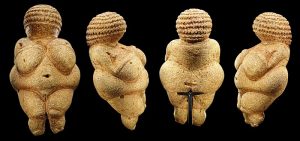
It is clear that modern Homo sapiens were excellent big game hunters. Sites abound with the remains of megafauna like mammoths. At the site of Dolni Vestonice in the Czech Republic, the remains of 800-900 mammoths were recovered. Excavations, ongoing since 1947, uncovered numerous structures constructed from mammoth bone, from windbreaks to roofed huts. Hearths, bird bones (flutes?), stone, bone and ivory tools, personal ornaments, a kiln and thousands of small fired clay figurines were found within the various structures. The variety of structures suggest that the site was occupied year-round.
Aesthetic expression in the form of portable and non-portable art becomes de rigor in the Upper Paleolithic. As mentioned above, personal adornment appears in the archaeological record. Necklaces, pendants and headbands made of shell, bone and ivory are found at numerous Upper Paleolithic sites. Carvings in bone, ivory and wood are evidenced in this period. Statues of clay also become common. The most well-known Upper Paleolithic carvings/clay moldings are the Venus figurines. These are small sculptures of human figures with exaggerated female characteristics–disproportional breasts, hips, thighs and buttocks. Other parts of the bodies, hands, feet, faces are not detailed. The first interpretation of these figurines was that they were fertility symbols representing Mother Earth. In 1996, LeRoy McDermott provided an alternate interpretation. He proposed that the Venus figurines were the first attempts at self-representation.
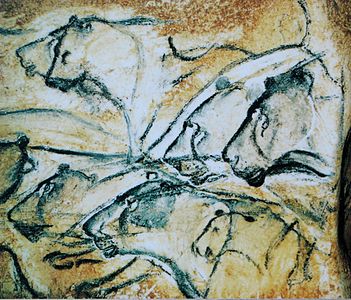
Non-portable art in the form of petroglyphs and cave paintings appear in the archaeological record around 36,000 years ago. Oval-shaped rock carvings (petroglyphs) appear at Wharton Hill, Australia. Cave paintings were found in Spain, Africa and Australia, although it is the cave paintings in France that are most well known. At Chauvet, France, over 300 paintings and engravings were found dating to 32,000-31,000 years. The paintings show us that the area was populated with animals that are now extinct in Europe: rhinoceros, lions, mammoths, and red panthers are a few example.
The most famous cave is Lascaux, France dated to 17,000 years. This cave was used extensively over time. Great effort went into creating these works of art. Many are found on the ceilings and in deep areas of the cave, where no natural light reached. Stone bowls were used as lamps to light these darks areas. The Upper Paleolithic artists used the natural formation of the cave to show movement of animals. The paintings were made with natural pigments made from minerals and cave water. Black, yellow, red and occasionally white were the colors that were created.
The subject of these murals is primarily animals. While some human figures are found, they are often simple stick-like figures or shown as an anthropomorphic, part-human, part-animal figure.
As with modern art, archaeologists have tried to interpret the themes of Upper Paleolithic art. The presence of animals and human figures with hunting weapons suggests that imparting hunting information was one of the purposes of the art. The number of seemingly pregnant animals leads to the conclusion that there was a concern with restocking food sources. Other possible explanations include imparting information about rituals, origin myths, proclamations, and feelings.
Around 17,000 years ago, one of the most coldest periods of the Pleistocene occurs. in the subsequent warming period, sea levels begin to rise and there is a worldwide extinction of the megafauna. This was most devastating in the Americas where modern humans had finally migrated. In response to environmental changes, modern humans began to settle for longer periods of time in semi-permanent and permanent villages. Around 12,000-11,000 years ago, the first domesticated plants and animals appear in the archaeological record. With the adoption of a sedentary lifestyle, human culture undergoes massive changes. To learn more about this topic, we suggest taking a class on world prehistory.
References
California Academy of Sciences [Internet]. 2010. Oldest evidence of stone tool use and meat-eating among human ancestors discovered: Lucy’s species butchered meat. ScienceDaily (August 10). [cited 2010 Oct 16]. Available from: http://www.sciencedaily.com/releases/2010/08/100811135039.htm
Campbell BG, Loy JD. 2005. Humankind emerging, 8th edition. Needham Heights (MA): Allyn & Bacon.
Harmand S, Lewis JE, Feibel CS, Lepre CJ, Prat S, Lenoble A, Boës X, Quinn RL, Brenet M, Arroyo A, Taylor N, Clément S, Daver G, Brugal JP, Leakey L, Mortlock RA, Wright JD, Lokorodi S, Kirwa C, Kent DV, Roche H. 2015. 3.3-million-year-old tools from Lomekwi 3, West Turkana, Kenya. Nature 521 (May 21): 310-315. Available from: http://www.nature.com.offcampus.lib.washington.edu/nature/journal/v521/n7552/full/nature14464.html. doi:10.1038/nature14464.
Jurmain R, Kilgore L. Trevathan W. 2013 Essentials in physical anthropology. Belmont (CA): Wadsworth Cengage Learning.
Larsen, CS. 2014. Our origins: discovering physical anthropology. New York (NY): W. W. Norton & Company, Inc.
McDermott L. 1996. Self-representation in the Upper Paleolithic female figurines. Curr Anthropol 37(2): 227-275.
Price, T. Douglas and Gary M. Feinman. 2010. Images of the past, 6th edition. New York: McGraw Hill.
Scarre, Chris. 2005. The human past: world prehistory & the development of human societies. London: Thames & Hudson Ltd.
Straus, Lawrence Guy. 2005. The Upper Paleolithic of Cantabrian Spain. Evolutionary Anthropology 14: 145-158.
Thieme H. 1997. Lower Paleolithic hunting spear from Germany. Nature [Internet] [cited 2015 Aug 21]; 385: 807-810. Available from: http://www.nature.com/nature/journal/v385/n6619/abs/385807a0.html
Thompson A. 2006. Neanderthals were cannibals, study confirms. LiveScience [Internet] [cited 2015 Aug 21]. Available from: http://www.livescience.com/1187-neanderthals-cannibals-study-confirms.html
Zorich Z. 2015. A place to hide the bodies. Archaeology [Internet] [cited 2015 Aug 21]; 68(5). Available from: http://offcampus.lib.washington.edu/login?url=http://search.ebscohost.com/login.aspx?direct=true&db=a9h&AN=108695657&site=ehost-live
Cite this page
APA Style: Saneda, T. M. 2022. Material culture. In T. M. Saneda & M. Field, Biological Anthropology: a brief introduction. Cascadia College Pressbooks.
Chicago Style: Saneda, Tori M. 2022. “Material Culture.” In Biological Anthropology: A Brief Introduction, 3rd. Bothell, WA: Cascadia College Pressbooks.
CSE Style: Saneda TM. 2010. Material culture. In: Biological Anthropology: a brief introduction, 3rd ed. Bothell (WA): Cascadia College Pressbooks. [modified 2022; accessed 2022 Dec 5]. https://openwa.pressbooks.pub/anth205bioanth/chapter/culture.

